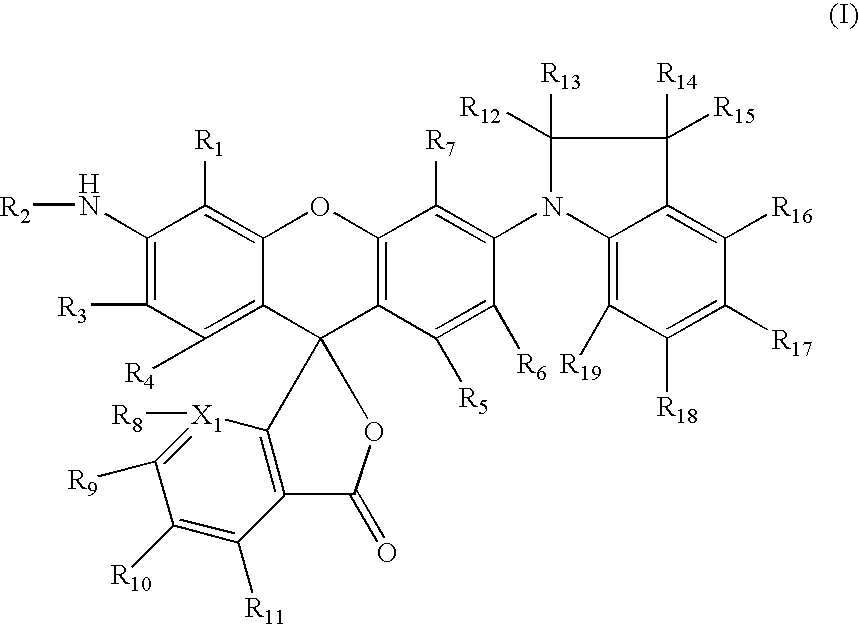Dyes and use thereof in imaging members and methods
a technology of dyes and imaging members, applied in thermography, instruments, photosensitive materials, etc., can solve the problems of affecting the quality of the final image, the storage of the medium (before printing or in the form of the final image) may need to be for years, and the direct thermal system is still sensitive to hea
- Summary
- Abstract
- Description
- Claims
- Application Information
AI Technical Summary
Benefits of technology
Problems solved by technology
Method used
Image
Examples
example 1
Synthesis of intermediates
Step 1A. Alkylation of 4-nitrocatechol
[0070]4-Nitrocatechol (23.26 g, 0.15 mol) and potassium carbonate (124.38 g, 0.9 mol) were placed in a one liter 3-neck flask fitted with a mechanical stirrer. Anhydrous dimethylformamide (350 mL) was added to this mixture followed by the addition to the suspension, dropwise, of 1-bromo octane (63.73 g, 0.33 mol). The reaction mixture was heated at 110° C. for 24 hours. The reaction was followed by TLC (2% methanol in methylene chloride). After the completion of the reaction the contents were cooled and poured dropwise with stirring into ice-water (1 L). The mixture was stirred for one hour and filtered. The collected solid was washed thoroughly with water, air-dried and then dried in vacuo at 30° C. This process produced brown crystals: (54.8 g, 0.144 mol, 96% yield). These crystals were used without further purification.
Step 1B. Synthesis of 3,4-dioctyloxyaniline
[0071]3,4-Dioctyloxynitrobenzene (25.25 g, 0.067 mol) wa...
example ii
Synthesis of Dye I
[0097]A mixture of hexachlorofluoran (2.0 g, 3.9 mmol), 2,3,3-trimethylindoline (0.9 g; 5.9 mmol), zinc chloride (1.6 g; 11.8 mmol), and zinc oxide (0.5 g; 5.9 mol) in sulfolane (6 g) was stirred with heating at 190° C. for 4 hours. To this mixture was added aniline (0.8 g; 7.9 mmol) and the mixture was then further stirred with heating at 160° C. for 14 hours. The mixture was cooled to 50° C. and quenched into 2N HCl (100 mL). The crude solid was isolated by filtration, washed with water several times and taken up in methylene chloride (150 mL). The methylene chloride solution was washed with sat. sodium bicarbonate (2×100 mL), dried over magnesium sulfate and the solvent removed. The residual solid was purified by column chromatography on silica gel (eluted with 30% ethyl acetate in hexane) to give 0.6 g pure product (22% yield) and then recrystallized from ca. 10% acetone in hexane to give colorless crystalline product, m.p. 210–215° C. (0.35 g, 13% yield).
[0098...
example iii
Synthesis of Dye II
[0099]A mixture of hexachlorofluoran (2.0 g, 3.9 mmol), indoline (0.7 g, 5.9 mmol), zinc chloride (1.6 g, 11.8 mmol), and zinc oxide (0.5 g, 5.9 mmol) in sulfolane (6 g) was stirred with heating at 145° C. for 90 minutes. To this mixture was added 4-(2-ethyl-1-hexyloxy) aniline (2.7 g, 7.9 mmol) and the mixture was further stirred with heating at 160° C. for 5 hours. The mixture was cooled to 50° C. and quenched into 2N HCl (100 mL). The crude solid was isolated by filtration, washed with water several times and taken up in methylene chloride (150 mL). The methylene chloride solution was washed with sat. sodium bicarbonate (2×100 mL), dried over magnesium sulfate and the solvent was evaporated. The residual solid was purified by column chromatography (10% ethyl acetate in methylene chloride) to give 1.2 g pure product (39% yield) and recrystallized from approximately 10% acetone / hexane to give colorless crystalline product (0.55 g, m.p. 180–182° C., 18% yield).
[01...
PUM
| Property | Measurement | Unit |
|---|---|---|
| melting temperatures | aaaaa | aaaaa |
| temperatures | aaaaa | aaaaa |
| melting temperatures | aaaaa | aaaaa |
Abstract
Description
Claims
Application Information
 Login to View More
Login to View More - R&D
- Intellectual Property
- Life Sciences
- Materials
- Tech Scout
- Unparalleled Data Quality
- Higher Quality Content
- 60% Fewer Hallucinations
Browse by: Latest US Patents, China's latest patents, Technical Efficacy Thesaurus, Application Domain, Technology Topic, Popular Technical Reports.
© 2025 PatSnap. All rights reserved.Legal|Privacy policy|Modern Slavery Act Transparency Statement|Sitemap|About US| Contact US: help@patsnap.com


